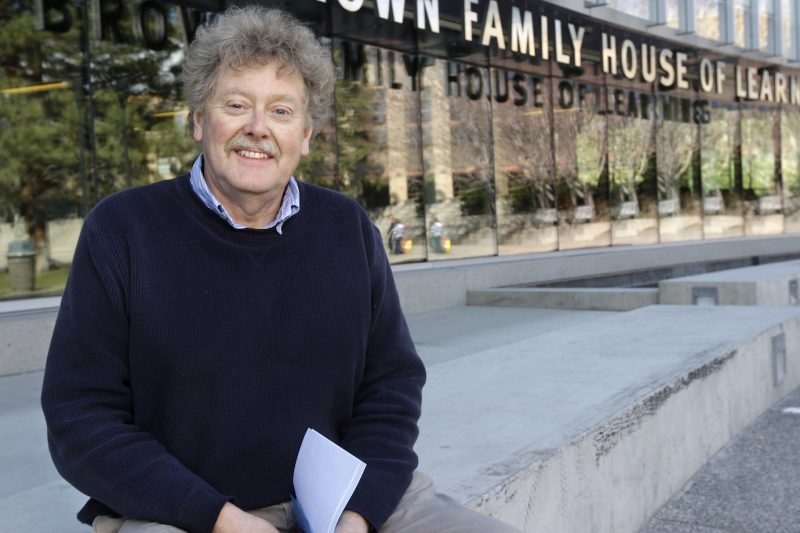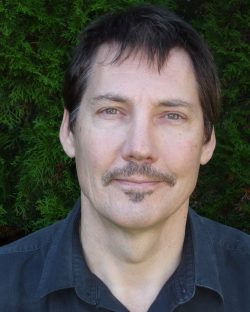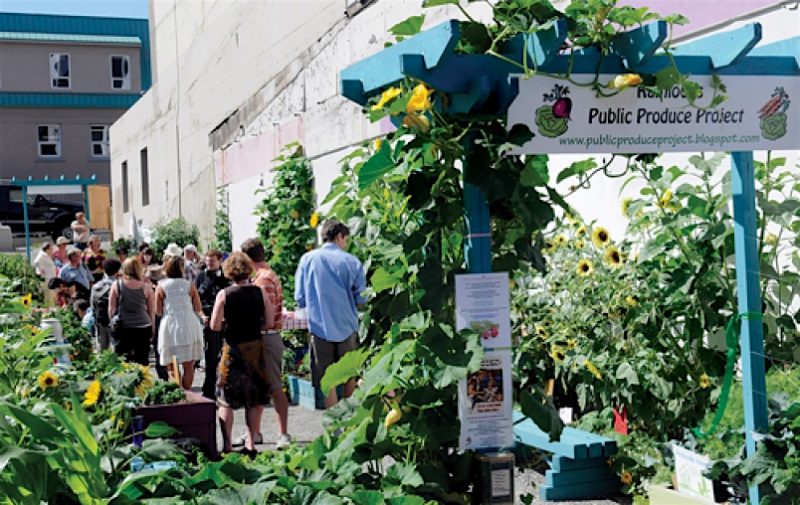#473 Small cities take centre stage
January 27th, 2019

Small Cities, Big Issues: Reconceiving Community in a Neoliberal Era
by Christopher Walmsley and Terry Kading (editors)
Edmonton: Athabasca University Press, 2018
$37.95 / 9781771991636
Free pdf available at: http://www.aupress.ca/index.php/books/120265
*
No Straight Lines: Local Leadership and the Path From Government to Governance in Small Cities
by Terry Kading (editor)
Calgary: University of Calgary Press, 2018
$39.95 / 9781552389447
Free pdf available at: https://press.ucalgary.ca/books/9781552389447
*
Both books reviewed by Michael Lait
*
Academics have overlooked small cities in favour of research into rural and larger urban communities in British Columbia. They have concentrated on the two extremes of cities on the lower mainland and southern Vancouver Island and on the much smaller, transient, and vulnerable camps and company towns of the logging, fishing, and mining industries.
Two scholars from Thompson Rivers University in Kamloops hope to change this focus. Christopher Walmsley of the Social Work department and Political Scientist Terry Kading present two edited collections of essays focused on Kamloops and touching also on Kelowna, Prince George, Abbotsford, New Westminster, and Nanaimo. – Ed.
*
Offering insight into how neoliberalism has affected marginalized groups in the contemporary neoliberal era, Small Cities, Big Issues, edited by Christopher Walmsley and Terry Kading of Thompson Rivers University (TRU) in Kamloops, undermines taken-for-granted assumptions about the social cohesion of B.C.’s small cities. The collection shows how neoliberalism has exacerbated class divisions and social conflicts through the downloading of federal and provincial responsibilities for welfare to municipal governments.
By championing the free and rational economic actor responsible for its own destiny, neoliberalism encourages the displacement and exclusion of vulnerable and marginalized groups, including the homeless, drug users, sex trade workers, parolees, immigrants, and LGBTQ and Indigenous communities. By foregrounding the struggles and experiences of the “Other,” Small Cities, Big Issues makes an important contribution to the discussion on neoliberal governance in small cities.
Small Cities, Big Issues provides ample evidence for the ongoing challenges faced by local governments following the downloading of federal and provincial responsibilities. In their chapter on housing and homeless, Kading and Walmsley explain the disadvantages of B.C.’s small cities, which have a limited housing stock and did not benefit from the earlier public land acquisition and housing programs implemented by the federal government in the 1970s.
Municipal governments in B.C.’s small cities were unprepared in other ways for the downloading of responsibilities. On the one hand, the chapters by Kading and Walmsley and by Robert Harding and Paul Jenkinson on New Westminster and Abbotsford detail how the budgetary constraints resulting from neoliberal austerity have prevented municipalities from effectively intervening on social issues. On the other, municipalities did not have social planners, let alone social planning departments, to identify and address the needs of vulnerable populations in the first place.
Kading and Walmsley indicate that these initial challenges have, to some extent, been overcome as social planners in Kamloops, Kelowna, Prince George, and Nanaimo have made headway with the adoption of plans to “end homelessness.” Nevertheless, City Councils remain very cautious in their approach to social issues, given the looming prospect of NIMBYism (“not in my backyard”) from business and property owners. However progressive the attitude taken by City Councils towards homelessness, NIMBYism proves time and time again to be a powerful reactionary force when proposals for supportive housing are brought forward.
Small Cities, Big Issues provides insight into the nuances of municipal government in B.C.’s small cities. Such governments have, on occasion, been complicit in the processes of exclusion and marginalization. Chapters here by Lorry-Ann Austin and Sydney Weaver document how, in the late 2000s, the governments of Kamloops and Nanaimo co-operated with the RCMP in the establishment and enforcement of “red zone” policies, with the explicit aim of removing sex trade workers and social service providers from the red zones, which, in the case of Nanaimo, encompassed the entire city limits.
Although the effects of neoliberalism on governance in small cities is the central theme of Small Cities, Big Issues, several of its essays focus on the perspectives and lived experiences of the Other in the small city. The chapter by Sharnelle Matthew and Kathie McKinnon offers an insightful critique of the differences between Western and Indigenous cultural paradigms, which are explored, respectively, through the metaphor of the Box and the Circle. Matthew and McKinnon recount their experiences as Indigenous health practitioners who are simultaneously working from the holistic principles of the Circle within the medical model characteristic of the Box. They write: “When we are called upon to respond to suicide, our double-sided card [of the Circle and the Box] is essential. It allows us to negotiate the very distinct administrative worlds of the coroner, the police, and the school while also walking with and through the waves of grief enveloping our communities” (p. 185).
The LGBTQ community also experiences othering in the small city. In her chapter, Wendy Hulko provides an ethnographic account of young and older lesbians who are trying to find the LGBTQ community in B.C.’s small cities. Hulko argues that the small city is a “middle ground.” It offers more of a sense of community for LGBTQ people than the rural and small town, but the “gay scene” is smaller and more difficult to access than in larger metropolitan cities.
Next up is TRU sociologist Monica Sanchez-Flores, who offers an auto-ethnographic account of her experience as a Mexican immigrant in Kamloops. She takes aim at the federal government, arguing that multiculturalism, as state policy, works to divide and racialize immigrants and keep them from from integrating with the white majority population. The sense of community found in small cities like Kamloops, she suggests, could instead be conducive to a “cosmopolitanism,” as residents hold an “attitude that regards people of all colours and origins as deserving of the same level of dignity and respect…” (p. 229).
When compared to the scholarship on metropolitan cities, studies of governance in small cities are relatively few in number, making Small Cities, Big Issues an important resource for researchers interested in the effect of neoliberalism on social exclusion and marginalization in small cities. However, with the important exception of Graham Day’s chapter on small cities in the United Kingdom, the chapters addressing neoliberalism do not sufficiently engage with the vast literature on the topic. There is no discussion of the broader context of neoliberalism and its historical antecedents: Keynesianism and classical liberalism are never even mentioned. More engagement with the literature would have revealed that there are significant variations in neoliberalism, particularly as it was imported from Germany into the United States.
The interesting and relevant questions of whether and how neoliberalism has been adapted to Canada in general, and the small city in particular, are left unaddressed. Instead, again with the exception of Day’s chapter, the discussion is narrowly focused on the effects of the downloading of social welfare by provincial and municipal governments. On the whole, then, neoliberalism appears in Small Cities, Big Issues as unidimensional, ahistorical, and static.
Social conservatism could also have been given more attention in this book. After all, it was quite influential in the late 2000s — the period covered by many of the essays here. A closer examination of social conservatism would have underscored how residents of small cities support the exclusionary processes documented in the collection. The homeless, panhandlers, drug addicts, and sex trade workers not only challenge traditional family values but, many residents believe, contribute to lower property values. Many chapters in Small Cities, Big Issues might have taken a broader view, not only of neoliberalism, but also of the effects of other ideologies on processes of marginalization, displacement, and othering in the small city.
*
The governance of the Other in the small city is also a focal point in Terry Kading’s edited collection No Straight Lines: Local leadership and the Path from Government to Governance in Small Cities. Chapters in this collection take up the themes of leadership and learning in community-university collaborations, in particular the impact of these collaborations on the “equality of quality of life” of Kamloops’ marginalized residents. This term, emphasized throughout the collection, is drawn from the work of urban design theorist Charles Montgomery and his principles for the “happy city.”
No Straight Lines presents a compelling case for the significant role played by universities through community-engaged research, as faculty members help establish collaborations with community groups with the intention of improving “equality of quality of life” outcomes according to Montgomery’s principles. Through these “leadership initiatives,” faculty create novel conditions for learning about community needs as well as the experiences of othering in the local community. Of course, not all collaborations are equal, and the collection draws on Lon Dubinsky’s typology of collaborations: coercive, normative, mimetic, organic, and self-interested collaborations.
While identifying the type of collaboration is key to understanding its strengths and limitations, Kading notes that leadership style is also an important factor in determining the success or failure of specific collaborations. The chapters in No Straight Lines that apply these frameworks consistently throughout the book differentiate between “transactional” and “transformational” leadership styles. Transactional leadership involves top-down processes in pursuit of specific objectives, whereas transformational leadership is strategic and flexible with regard to objectives.
In his own chapter on local responses to the federal government’s homelessness programs, Kading argues that these examples of “coercive collaboration” (p. 61) involve transactional leadership. These homelessness programs facilitated local leadership but federal authorities were not prepared to negotiate program objectives with local leaders. Rather, the federal government’s objectives were restricted to “managing” homelessness. A collaboration based on transformational leadership, Kading argues, would have been focused on more ambitious strategies of “ending homelessness” in Kamloops, thereby fully contributing to equality of quality of life outcomes.
Next in order is TRU anthropologist Lisa Cooke, who describes a tangible equality of quality of life outcome for the homeless of Kamloops with the construction of a shower facility by United Steelworkers Local 7619 at the ASK Wellness Centre, a non-profit social services agency. For Cooke, the collaboration was “organic” as it evolved from Local 7619’s cook events for the homeless. A core group recognized that a number of people were deterred from attending these events on account of their physical hygiene.
Having identified this need among the homeless population, a leadership initiative involving ASK Wellness and Local 7619 was established. As Cooke reveals, this leadership was transformative, not only through the construction of the showers, but also in overcoming the initial concerns of downtown business owners. To overcome these concerns, the leader of ASK Wellness engaged in extensive “community making” that forever altered what Cooke calls the “ecology of compassion” in Kamloops downtown.

Rehearsal for Home/Less/Mess at Stage House Theatre, Kamloops, July 2014, with visiting media. L-R: Zoe Shiloh, Kirk Unsworth, Brian Berube
Dawn Farough’s chapter recounts the planning, organization, and production of an original play, entitled Home/Less/Mess, written and performed by the homeless in 2014. Farough and other academics from TRU spearheaded this leadership initiative, known as “No Straight Lines,” which recruited homeless actors and relied upon their expertise to communicate everyday issues encountered by the homeless to a broader audience. Farough’s account details the power struggles among the actors, and between the actors and the academics involved, with their privileged class position. Whereas macro-level realities sometimes impeded the homeless actors’ ability to participate, Farough was struck by how, “[o]n the micro-stage … our actors were incredibly strong people who understood the interdependency of the play and the research project” (p. 138). The play sold out for five performances, and a survey of the audience revealed that, through the play, they had become more aware of the issues arising from people’s experience of homelessness.
In their essay, Robin Reid and Kendra Besanger describe the Kamloops Public Produce Project, a two-year initiative that tackled issues of food security by providing a place for residents to grow their own food. Reid and Besanger emphasize the place-making function of the public garden. Unlike community gardens, which are frequently gated with individual plots, open and freely accessible public produce gardens, particularly in a downtown core, contribute to equality of quality of life by enhancing food security.
As Reid and Besanger explain, “The space itself invites public engagement and challenges the sense of ownership that so frequently dictates public behaviour in urban spaces” (p. 163). The public produce garden was succeeded by a permanent one managed by the City of Kamloops, though the city’s garden has elements of both community and public produce gardens.
Ginny Ratsoy’s chapter on the Kamloops Adult Learners Society focuses on the transformational leadership of this volunteer-driven non-hierarchical group as it responds and adapts to the varied interests of its growing membership. Ratsoy notes the organic collaboration that emerged between the KALS and faculty from TRU primarily through informal and serendipitous contact.
An essay by TRU historian Tina Block recounts the Tranquille Oral History Project, which was intended to record the memories and experiences of former residents and employees of Tranquille, a mental health facility outside of Kamloops that closed in 1984. The collaboration was initiated by a developer and involved TRU faculty as well as the Kamloops Heritage Society. According to Block, the collaboration was “self-interested” because the developer sought to preserve Tranquille’s heritage mainly as a means of countering resistance from community members attached to the historic site.
Unlike the other community-university collaborations documented in No Straight Lines, Block describes an ineffective leadership structure, one that could not reconcile the interests of academic researchers with those of corporate and community partners. As a result, TOHP was a short-term research project, which Block believed should have been permanent and long-term.
Taken together, the contributions to No Straight Lines undercut prevalent notions of leadership in small cities, namely the assumption that local leaders are drawn from the ranks of the pro-growth coalition. This collection reveals less visible but highly impactful forms of leadership. To this end, these essays are also important in demonstrating that community-engaged research can be an important vehicle for transformative leadership and “equality of quality of life” outcomes.
I did have some reservations and questions. First, there is the question of whether Kamloops can serve as a representative proxy for small cities in Canada or elsewhere. The contributors themselves frequently note the strength of Kamloops relative to other small cities, both in the pre-existing levels of community engagement and in the widespread awareness of social issues.
Even if Kamloops could serve as a proxy for small cities, the attempts at comparison with metropolitan centres are largely unsupported by any empirical evidence. For instance, Kading writes in the conclusion that “status or elitism were not as evident in Kamloops as they might be in larger urban centres….” (p. 235). Statements like this are found throughout the collection. It would have been more accurate to position No Straight Lines as a Kamloops-specific collection. As it stands, the cases presented here do not support the generalization about “small cities” that is implied in the collection’s subtitle.
The most surprising shortcoming of No Straight Lines is the omission of neoliberalism from the discussion. Instead, there are references to a “new governance.” Again, substantive discussion of historical antecedents is lacking, such that there is no explanation of when, how, or why the transformation from government to governance occurred. There is even some alignment with neoliberal discourse in the emphasis on entrepreneurial leadership and building different forms of capital. Given that neoliberalism is the central concept in Small Cities, Big Issues, the substitution for “new governance” does a disservice to both collections. The critique of neoliberalism should not only have been sustained, but extended to include studies of the neoliberal university.
What are the connections between the growing emphasis on community-engaged research and the neoliberal university? This is a question that is left unaddressed in No Straight Lines, but it is a discussion worth having, especially since community-engaged research aims to be reciprocal; yet as Walmsley and Kading assert in Small Cities, Big Issues, neoliberalism has been noted to be “a philosophy that has little use for empathy” (p. 18).
*
Michael Lait is an instructor in the Department of Sociology at Vancouver Island University. From 2017 to 2018, he was a postdoctoral fellow with the Community Development Institute at the University of Northern British Columbia. Michael’s interests include environmental sociology, human geography, regional governance and planning, and community-based research methods. His research has been published in regional, national, and international journals.
*
The Ormsby Review. More Books. More Reviews. More Often.
Editor/Designer/Writer: Richard Mackie
Publisher/Writer: Alan Twigg
The Ormsby Review is a journal service for serious coverage of B.C. books and authors, hosted by Simon Fraser University. The Advisory Board consists of Jean Barman, Robin Fisher, Cole Harris, Wade Davis, Hugh Johnston, Patricia Roy, David Stouck, and Graeme Wynn. Scholarly Patron: SFU Graduate Liberal Studies. Honorary Patron: Yosef Wosk. As of September, 2018, Provincial Government Patron: Creative BC
“Only connect.” – E.M. Forster
Poster for Home/ Less/ Mess. Courtesy of Bonnie McLean



















Leave a Reply